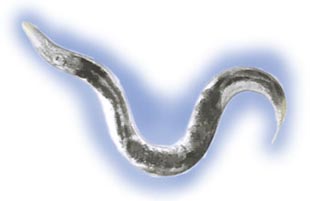| Objectives | Background | Current Projects | Current Grants | Data Summaries |
Classical and molecular approaches to the genetics of aging
WORM

Objectives
Getting insights into the mechanisms of aging using the nematode worm Caenorhabditis elegans as a model.
Background
Aging is a multifactorial phenomenon; yet, the accumulation of damages to macromolecules plays a crucial role. Among virtually all eucaryotes the major source of damaging compounds is metabolism itself. The cellular respiration metabolizing oxygen generates as by-products highly reactive oxygen species (ROS: O2.-, H2O2, .OH and derived metabolites) that can react with and damage macromolecules. It is estimated that ~1 to 2 % of the oxygen metabolized by aerobic cells is diverted to the generation of O2.- and subsequent metabolites.
All organisms have evolved a diverse array of mechanisms to prevent accumulation of damages principally by producing (1) molecules that scavenge toxic environmental and metabolic by-products such as ROS (e.g. antioxidant enzymes, non-enzymatic free radical scavengers), (2) systems that repair damage to macromolecules, and (3) by destruction/replacement of effete macromolecules and cells (apoptosis, cell renewal, turnover of cell components). These anti-damage defenses are not fully efficient and cells are chronically injured. Once the protective processes are themselves injured, the accumulation of damages will further increase. Furthermore, damages in oxygen metabolism can lead to chemical energy cutback together with over-production of ROS (rates of O2.-, H2O2 generation increase with age in several different organisms). Therefore (oxidative) damages to macromolecules form a vicious cycle where damages become more and more critical and generalized, participating in the progressive generalized alterations observed in aging.
There is an intimate relationship between longevity and the ability to prevent/repair chronic damage to macromolecules. The efficiency of anti-damages mechanism may be revealed by the ability to endure environmentally imposed stress. Such “external” stress can be considered as an exacerbation of the chronic endogenous accumulation of damages. Many environmental or genetic interventions that increased longevity also increased resistance to environmental stress. There is a good correlation between stress resistance and longevity. It appears that the capacity to control the accumulation of damages modulates both longevity and environmental stress resistance.
The nematode Caenorhabditis elegans is becoming an increasingly important model for the study of aging. A handful of single-gene mutations that dramatically increase the mean life span of this organism have been identified. All long-lived mutant C. elegans are also resistant to some variety of environmental stress such as high temperature, reactive-oxygen-species (ROS), and UV irradiation. These observations are of relevance to the damage accumulation theory of aging and it can be concluded that stress resistance and life expectancy are generally linked.
Research in aging is still in its infancy and represents an exciting new field. As C. elegans is a very good model for the study of metazoan senescence, our ongoing studies offer exciting opportunities to gain insight into the processes coordinately modulating life expectancy and the stress response.
See also:
The Chronicle of Higher Education (Kim McDonald article about worms and aging)
Current Projects
- "Demographic Models and Analyses" : This project examines the mortality kinetics as a function of age in large populations of normal and mutant nematodes.
- "Stress resistance and life span" : This project examines the relationships between life span and stress resistance, using comparative studies of stress resistance versus longevity, stress reporter lines, and forward genetic screens for stress-resistant mutants.
Current Grants
National Institute on Aging: "Oldest-Old Mortality: Demographic Models and Analyses" (1995-2008).
National Institute on Aging: "Transgenic C. elegans as Amyloid Disease Model," (1996 - 2007)
National Institute on Aging: "Molecular Genetics of Aging in C. elegans," (1999 - 2004)
National Institute on Aging: "Transgenic C. elegans as Amyloid Disease Model," (2003 - 2007)
Data Summaries
- Rea, S.L., Wu, D., Cypser, J.R., Vaupel, J.W., Johnson, T.E., 2005. A
stress-sensitive reporter predicts longevity in isogenic populations
of Caenorhabditis elegans. Nat Genet 37, 894-898.
Sorter experiment data
- David Shook's C.elegans RI data
- Gerontogenes table - list of gerontogenes found in the nematode worm Caenorhabditis elegans
- Correlation between life expectancy and stress resistance
- Rea, S. L., Ventura, N and Johnson, T. E., (2007) Relationship between
mitochondrial electron transport chain dysfunction, development and life
extension in Caenorhabditis elegans. PLOS Biology, 5(10): e259
supplemental material
| Mouse | People | Publications | Links | Home |